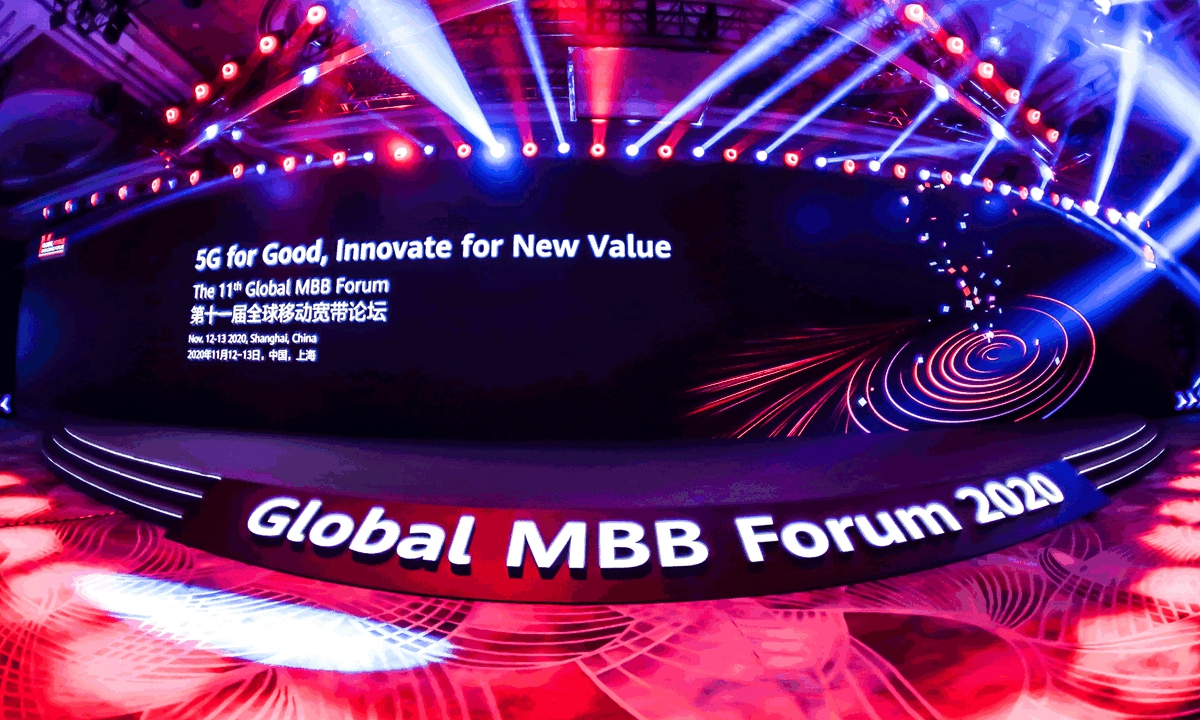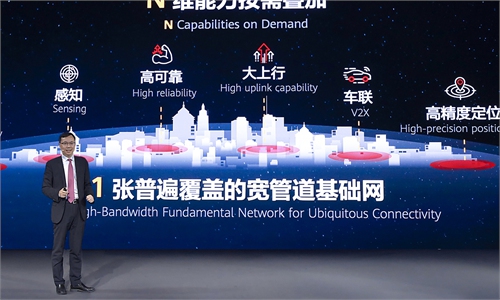SOURCE / PRESS RELEASE
Defining 5.5G for a better, intelligent world: Huawei’s David Wang
Huawei 5.5G vision

Huawei's Executive Director David Wang Photos: Courtesy of Huawei
At the 2020 Global Mobile Broadband Forum (MBBF) in East China's Shanghai Municipality on November 13, David Wang, Huawei's executive director, gave a keynote speech titled "Defining 5.5G for a Better, Intelligent World."At this year's two-day forum, officials from 5G leader Huawei joined hands with representatives of global operators, regulatory agencies, partners, analysts and other ICT industry elites to share their thoughts on global industry trends and hot topics, including the development of 5G, AI and ICT technologies.
5.5G will be an evolution of 5G, and Huawei looks forward to working with industry partners to define 5.5G, Wang said.
Each generation of mobile communications technology has reigned for about a decade, before being superseded by a new standard. 5G will be the major mobile communications technology until 2030 and will likely be in service until 2040. The development history of 2G, 3G, and 4G over the past 30 years shows that, even within each generation, continuous evolution is necessary to fully unleash the potential of the technology and advance the development of the industry.
In preparation for the day when 5G will support 100 billion connections, Huawei has proposed its vision for 5.5G. The 5G leader aims to inject more vitality into 5G, and create new value for the development of our societies and industry upgrades.
Huawei calls for partners to join hands to improve real-time interaction experience for individual users, enhance cellular Internet of Things (IoT) capabilities, and explore new scenarios, including Uplink Centric Broadband Communication (UCBC), Real-Time Broadband Communication (RTBC), and Harmonized Communication and Sensing (HCS), for a better, intelligent world.

A sign of 5.5G at the 2020 Global Mobile Broadband Forum
Internet of everythingConnecting people is the basic function of 5G. Mobile networks were first created to keep people connected, anytime and anywhere. Between now and 2030, 5G will increasingly help people interact with the virtual world in real time and deliver a truly immersive experience. 5G-empowered VR/AR has made interaction between the physical and virtual worlds a reality. However, to deliver an XR Pro and holographic experience, cellular communication will have to provide higher speeds: The average access speed will need to increase from the 120 Mbit/s that supports today's 4K video streaming to the 2 Gbit/s necessary for 16K video. In addition, lower interaction latency will be needed: the current 20ms will need to be brought down to 5ms. To meet all these requirements, 5G needs to keep evolving.
Connecting things is a major extension of 5G. Huawei's vision and mission is to bring digital to every person, home and organization for a fully connected, intelligent world. Connectivity and computing will be the building blocks of this intelligent world, and 5G will be the most critical connectivity technology. Looking ahead to 2030, cellular networks will have more than 100 billion connections, and most of them will be based on 5G. This magnitude is higher than the 1.3 billion IoT connections we have today. 5G needs to keep evolving to meet the ever more diverse needs of the IoT across all scenarios.
"5.5G is our vision for the industry. It is an enhancement and extension of the three standard 5G scenarios defined by the ITU -eMBB, mMTC, and URLLC," noted Wang.
The introduction of REDCAP means more device types will be available, providing the diverse range of devices needed by broadband IoT in the mMTC scenario. Optimizations in latency with a certain level of reliability allow for smart manufacturing like remote motion control in the URLLC scenario. As industry intelligent upgrades accelerate, a diverse range of IoT application cases will emerge and 5G application will also diversify. For example, some application cases require both massive connections and super large uplink bandwidth; some need communication and sensing capabilities. Therefore, 5.5G will cover three more scenarios than 5G: UCBC, RTBC, and HCS.
"Going beyond the original three application scenarios to six, 5.5G will take us beyond the Internet of Everything, enabling the intelligent Internet of Everything," said Wang.

Panorama of the 2020 Global Mobile Broadband Forum
5.5G valueThe new scenarios enabled by 5.5G will create new value for social development and industry upgrades, Wang noted.
UCBC will accelerate the intelligent upgrade of industries. Built on the foundation of 5G capabilities, UCBC will enable a 10-fold increase in uplink bandwidth. This is a perfect fit for manufacturers who need to upload videos in machine vision and massive broadband IoT, accelerating the intelligent upgrade of industries.
UCBC can also greatly improve user experience with mobile phones in indoor scenarios, with its deeper coverage and larger uplink capacity.
RTBC will deliver an immersive, true-to-life experience. RTBC supports large bandwidth and low communication latency. The goal is to deliver a 10-fold increase in bandwidth with a given latency and a certain level of reliability.
By achieving these goals, we can give users an immersive experience when they interact with the virtual world, Wang said.
HCS enables autonomous driving. HCS is designed to enable connected cars and connected drones, scenarios in which autonomous driving is the key requirement. By applying the beam scanning technology of Massive MIMO to the sensing domain, HCS can offer both communication and sensing functions. In indoor scenarios, HCS is capable of providing location services.
Sub-100 GHz usage pattern needs to be restructured to maximize the value of spectrum. To realize the industry's vision, 5.5G needs to use more sub-100 GHz spectrum for full-band uplink and downlink decoupling and full-band carrier aggregation on demand.
With AI, 5G networks have limitless intelligence. The 5G era will see more frequency bands, and more types of devices, services, and customers than any previous generation. 5.5G needs to fully integrate with AI to address all these complexities.
At the forum, the Huawei executive put forward proposals for 5.5G. He urged industry stakeholders to start working on 5.5G within the 3GPP framework as soon as possible.
Wang called for the industry to drive a thriving 5.5G industry ecosystem by making the most of the sub-100 GHz spectrum to provide diversified network capabilities and devices and overhaul cellular IoT.
The industry needs to further integrate 5G into verticals to create more use scenarios and accelerate digital and intelligent transformation, Wang said.


